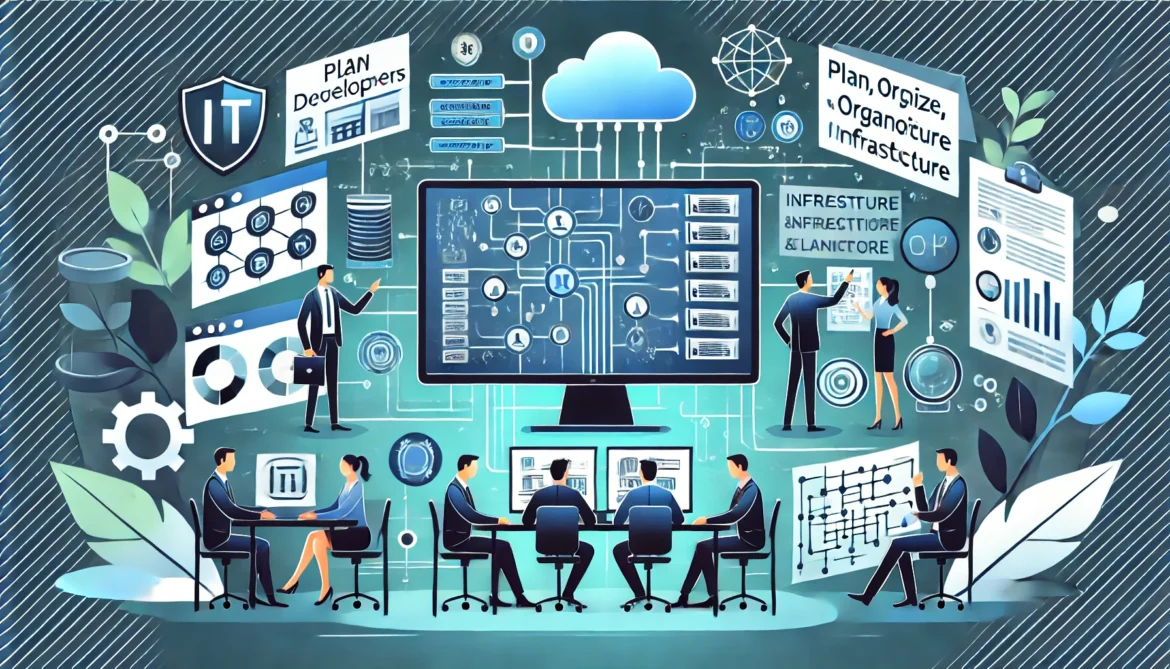Table of Contents
In today’s digital age, the success of any organization heavily relies on the robustness and efficiency of its IT systems. IT managers and developers play a critical role in ensuring that these systems are well-planned, organized, and controlled to meet the evolving needs of the business.
This article explores strategies for effectively managing IT infrastructure, focusing on planning, organizing, and controlling IT systems to achieve optimal performance and scalability.
Understanding the Importance of IT Infrastructure Management
IT infrastructure encompasses the hardware, software, network resources, and services required for the existence, operation, and management of an enterprise IT environment. Effective management of this infrastructure ensures:
- Operational Efficiency: Streamlined IT operations that support business processes.
- Scalability: The ability to grow and adapt IT resources to meet increasing demands.
- Security: Protection of data and systems from threats and vulnerabilities.
- Cost Management: Efficient use of resources to control and reduce costs.
- Compliance: Adherence to industry standards and regulatory requirements.
Network Diagramming
Creating a network diagram is a crucial aspect of planning and managing IT infrastructure. It involves creating visual representations of a network’s structure and components, providing a clear overview of how different elements are connected and interact with each other.
1. Importance of Network Diagrams
Network diagrams help IT managers and developers understand the layout and configuration of the network, making it easier to identify inefficiencies, troubleshoot issues, and plan for expansions or upgrades. They provide several key benefits:
a. Visualization of Network Structure
Network diagrams offer a visual representation of the network’s architecture, showing how devices such as routers, switches, servers, and endpoints are connected. This visualization aids in understanding the overall network design and identifying potential points of failure.
b. Improved Communication
Network diagrams serve as a communication tool among IT team members and stakeholders. They provide a common reference point, ensuring that everyone involved has a clear understanding of the network layout and configuration.
c. Efficient Troubleshooting
When network issues arise, diagrams can quickly help pinpoint the location of problems, reducing downtime and improving response times. They provide a roadmap for troubleshooting, making it easier to isolate and resolve issues.
2. Types of Network Diagrams
There are several types of network diagrams, each serving different purposes:
a. Physical Network Diagrams
These diagrams show the physical layout of the network, including hardware components and their physical connections. They are useful for planning hardware installations, upgrades, and troubleshooting physical issues.
b. Logical Network Diagrams
Logical diagrams represent the flow of data within the network, including IP addresses, subnets, and routing paths. They are essential for understanding how data moves through the network and for designing network security measures.
c. Detailed Network Diagrams
These combine elements of both physical and logical diagrams, providing a comprehensive view of the network. They include detailed information about hardware, software, configurations, and data flow.
3. Creating Network Diagrams
a. Gather Information
Collect detailed information about all network components, including devices, connections, IP addresses, and configurations. This information forms the basis for the network diagram.
b. Use Diagramming Tools
Utilize network diagramming tools that offer templates and features that simplify the process of creating accurate and detailed diagrams.
c. Design the Diagram
Begin by placing the primary components, such as routers, switches, and servers. Then, connect these components with lines representing network cables or wireless connections. Add details like IP addresses, subnets, and device names to provide a complete picture.
d. Regular Updates
Keep network diagrams up-to-date to reflect any changes in the network. Regular updates ensure that the diagrams remain accurate and useful for planning, troubleshooting, and communication.
Strategies for Planning IT Infrastructure
Planning is the first step in managing IT infrastructure. It involves defining objectives, assessing current capabilities, and designing a roadmap for future development.
1. Assess Current Infrastructure
Begin by conducting a comprehensive assessment of the current IT infrastructure. This includes evaluating hardware, software, network components, and data storage. Identify strengths, weaknesses, and areas that require improvement.
a. Inventory Management
Create a detailed inventory of all IT assets. Use inventory management tools to track hardware and software assets, their configurations, and their life cycles. This information is crucial for planning upgrades and replacements.
b. Performance Analysis
Analyze the performance of existing systems. Use performance monitoring tools to gather data on system utilization, response times, and error rates. This analysis helps identify bottlenecks and areas that need optimization.
2. Define Business Objectives and Requirements
Align IT infrastructure planning with the overall business objectives and requirements. Understand the strategic goals of the organization and how IT can support these goals.
a. Stakeholder Engagement
Engage with key stakeholders, including business leaders, department heads, and end-users. Gather their input on current challenges, future needs, and desired outcomes. This ensures that the IT infrastructure aligns with business priorities.
b. Requirement Specification
Document detailed requirements for the IT infrastructure. This includes performance expectations, scalability needs, security requirements, and compliance standards. Use these specifications to guide the planning process.
3. Design Scalable and Flexible Architectures
Design IT architectures that can scale and adapt to changing business needs. Flexibility and scalability are essential for accommodating growth and technological advancements.
a. Modular Design
Adopt a modular approach to IT architecture. Design systems in modular components that can be independently upgraded or replaced. This allows for easier scalability and reduces the impact of changes on the overall system.
b. Cloud Integration
Consider integrating cloud services into the IT infrastructure. Cloud solutions offer scalability, flexibility, and cost-efficiency. Evaluate the suitability of public, private, or hybrid cloud models based on business needs.
Strategies for Organizing IT Infrastructure
Organizing IT infrastructure involves structuring resources and processes to ensure efficient operation and management.
1. Establish a Clear Governance Framework
Implement a governance framework that defines roles, responsibilities, and processes for IT management. Effective governance ensures accountability and streamlined decision-making.
a. IT Governance Policies
Develop IT governance policies that cover areas such as data management, security, procurement, and change management. Ensure these policies are communicated and adhered to across the organization.
b. Role-Based Access Control
Implement role-based access control (RBAC) to manage user permissions. Define roles based on job functions and grant access to systems and data accordingly. This enhances security and ensures that users have the necessary access to perform their duties.
2. Standardize Processes and Procedures
Standardizing processes and procedures improves consistency and efficiency in IT operations. Documenting and following standardized practices ensures that tasks are performed correctly and reduces the risk of errors.
a. IT Service Management (ITSM)
Adopt ITSM frameworks, such as ITIL (Information Technology Infrastructure Library), to standardize IT processes. ITIL provides best practices for managing IT services, including incident management, problem management, and change management.
b. Standard Operating Procedures (SOPs)
Develop and document SOPs for routine IT tasks, such as system backups, software updates, and network maintenance. Ensure that these procedures are easily accessible to the IT team and regularly updated.
3. Implement Efficient Resource Management
Efficient resource management ensures that IT assets are utilized optimally and costs are controlled.
a. Capacity Planning
Perform capacity planning to ensure that IT resources can meet current and future demands. Monitor resource usage and forecast future requirements to plan for capacity upgrades.
b. Asset Management
Implement asset management practices to track and manage IT assets throughout their lifecycle. Use asset management tools to automate tracking, maintenance, and disposal of assets.
Strategies for Controlling IT Infrastructure
Controlling IT infrastructure involves monitoring, managing, and securing IT resources to ensure optimal performance and compliance.
1. Monitor and Manage Performance
Continuous monitoring and management of IT systems are essential for maintaining performance and identifying issues before they impact operations.
a. Performance Monitoring Tools
Use performance monitoring tools to track system metrics, such as CPU usage, memory utilization, network traffic, and application performance. Set up alerts for critical thresholds to ensure timely intervention.
b. Incident Management
Implement an incident management process to handle IT issues efficiently. Use ticketing systems to log, prioritize, and resolve incidents. Analyze incident data to identify trends and recurring issues.
2. Enhance Security Measures
Security is a critical aspect of IT infrastructure management. Implement robust security measures to protect systems and data from threats.
a. Security Policies and Procedures
Develop and enforce security policies and procedures, including access control, data encryption, and incident response. Regularly review and update security measures to address emerging threats.
b. Network Security
Implement network security measures, such as firewalls, intrusion detection systems, and virtual private networks (VPNs). Conduct regular security audits and vulnerability assessments to identify and mitigate risks.
3. Ensure Compliance and Risk Management
Compliance with industry standards and regulatory requirements is essential for avoiding penalties and maintaining trust.
a. Regulatory Compliance
Identify relevant regulatory requirements, such as GDPR, HIPAA, or PCI-DSS, and ensure that IT systems comply with these standards. Conduct regular compliance audits to verify adherence.
b. Risk Management Framework
Implement a risk management framework to identify, assess, and mitigate risks. Conduct risk assessments to evaluate potential threats and develop mitigation strategies. Regularly review and update risk management plans.
Mastering IT systems requires a strategic approach to planning, organizing, and controlling IT infrastructure. By conducting thorough assessments, aligning IT with business objectives, designing scalable architectures, establishing clear governance frameworks, standardizing processes, implementing efficient resource management, enhancing security measures, and utilizing network diagramming, IT managers and developers









